| Moomba Festival | |
|---|---|
 Waterskiing events at Moomba | |
| Genre | Carnival |
| Begins | Labour day long weekend (second Monday in March) |
| Frequency | annual |
| Location(s) | Melbourne, Australia |
| Years active | 68 |
| Inaugurated | 1955 |
| Previous event | 2020 |
| Attendance | 3.8 million (2.3 million tourists; record, set in 2018) |
| Organised by | City of Melbourne |
| Website | moomba.melbourne.vic.gov.au |
Moomba (also known as the Moomba Festival) is held annually in Melbourne, Australia. Run by the City of Melbourne, it is Australia's largest free community festival.[1] The Melburnian tradition is celebrated over four days, incorporating the Labour Day long weekend, from Friday to the second Monday in March. Moomba is culturally important to Melbourne, having been celebrated since 1955, and regularly attracts up to a million people, with a record attendance of 3.8 million (2.3 million tourists) set in 2018.
In 2003, the event was renamed Melbourne Moomba Waterfest.
Traditional events include the Moomba parade, crowning of Moomba monarchs, fireworks displays, carnivals in the gardens along the river, river activities including watersports, water floats and the Birdman Rally, as well as live music and bands.
In 2021, the usual Moomba was cancelled by Melbourne City Council, for the first time ever, due to events and issues related to the COVID-19 pandemic in Australia. However "Moomba 2.0" events were held on 5–8 March.
Origins
In 1951, Australia celebrated fifty years of Federation with a parade and the staging of the theatre production An Aboriginal Moomba: Out of the Dark. In 1954, Queen Elizabeth II visited the city for the first time as reigning monarch, and the City Development Association and the Melbourne City Council proposed an autumn carnival to be known as "Moomba".[2] A committee was formed in July, 1954 to organise and fund the event, successfully allocating £10,000 to its inaugural running. Before the event's first year, controversy was created when Labor Councillor Frank Williams resigned from the committee, branding the planned carnival as a "Bourke street joke for the benefit of shopkeepers".[3] A promotional theme song "Come to Melbourne for the Moomba" was written by Jack O'Hagan.
Etymology
The festival was originally named Moomba by organisers in the belief it was a native word meaning 'let's get together and have fun.' Credit is usually given to Bill Onus, a unionist and member of the Australian Aborigines' League for proposing the term, which he used in a play, Aboriginal Moomba in 1951.[4] In 1969 Luise Hercus glossed the word mum (rhyming with 'vroom')[5] as meaning 'bottom, rump', and suggested mum-ba meant something like 'bottom and..', and had been introduced from Healesville usage as a joke.[6] In 1981 Barry Blake analysed the word as combining as mum (anus) and –ba, a locative suffix meaning 'at, in, on'. This would give the sense of 'up your bum/arse'.[7][8]
Onus himself, according to his daughter-in-law, who said she had heard the story from Onus's wife Mary, had picked up the word from a word list of indigenous terms.[4] Some say he did it to get back at the city council for having deliberately upstaged the traditional Labour Day march with a popular carnival. Lin Onus, his son, stated that indeed his father had intended to play a prank in passing on the word with this sense.[5]
Event history
The first Moomba was a 15-day festival officially opened on 12 March 1955 by the State Governor, Sir Dallas Brooks.[9] The inaugural programme included a fireworks display, parade, vintage car display, Henley rowing regatta, river floats including a "Lord Mayor's houseboat", cycling race, tennis at Kooyong, concerts including performances by the Victorian Symphony Orchestra and Royal Philharmonic choir, crowning of the Queen of Moomba and riverside carnival. 25,000 turned out to watch the inaugural Moomba parade down Swanston Street. The first Moomba was heavily criticised by Melbourne's conservative establishment, including the Anglican Church, which at the time claimed it was hedonistic and embodying social decay.[10] Council responded to the criticism citing that Moomba was intended to be a festival for families and as such is reinforcing family values in society.[11]
One of the popular events associated with Moomba was the Herald Sun Outdoor Art Show in the Treasury Gardens.[12][13]
After the 2016 Moomba festival fireworks there was a large-scale brawl in and around Federation Square in Melbourne's Central Business District, largely between members of two gangs, Apex and Islander 23.[14][15]
2021 – Moomba 2.0
In 2021 the usual Moomba events were cancelled by Melbourne City Council, for the first time ever, due to COVID-19 restrictions and Victoria's third lockdown in February. The Moomba Parade and the Birdman Rally were already cancelled.[16]
Instead of the normal festival attractions, Lord Mayor Sally Capp said Moomba 2.0 will be: "... a series of fun, family friendly events and attractions across the city that will help bring the buzz back to Melbourne." There will be ticketing and COVID-safe marshals across all sites. Moomba 2.0 will be a COVID-safe event.[17]
Events
Parade and floats
A parade (or "procession") and floats through the streets of Melbourne have been a key part of the Moomba festival since its beginning. Each year it attracts over 100,000 people to Melbourne's city centre as well as being shown on free-to-air television in Melbourne.
The first Moomba procession was held in 1955. It was first televised in 1957, the year after the Melbourne 1956 Olympics.
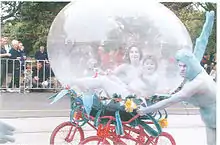
The floats have an annual theme, usually an elaboration on "Let's get together and have fun", the avowed mission and vision statement of Moomba and are usually from sister cities (of which Melbourne has six), schools and community groups. They also promote some aspect of the arts, like singing, dancing, or design. Swanston Street is the traditional home of the floats and spine of the city and horse- or tractor-drawn floats use the tram tracks. Decorated trams are sometimes also featured.
In 2001, the parade came under media controversy when a French Troupe and Melbourne's Snuff Puppets had floats with naked people covered in body paint.
Moomba monarchy
The Moomba monarchy has been one of the most celebrated and controversial components of the festival over the years.[18]
Queens of Moomba (1955–1987)
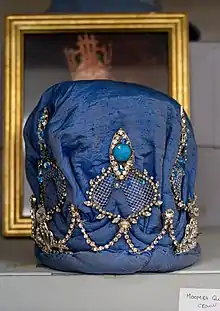
The first Moomba monarchs were the Queens of Moomba, awarded from the inaugural festival in 1955.[19] The role was decided by a beauty pageant competition. It was awarded for the last time in 1987, as a new gender-neutral monarch position was established and the beauty pageant was abolished.
Notably, 1966 Moomba Queen Erica McMillan was killed in a car accident seven weeks after the festival, in the car which she had received as a prize for being voted Queen.[20]
| Year | Queen |
|---|---|
| 1955 | Beverley Stewart |
| 1956 | Fay Chapman |
| 1957 | Patricia Bramwell |
| 1958 | Norma Jones |
| 1959 | Honni Freger |
| 1960 | Pat Tudor |
| 1961 | Rhonda Parker |
| 1962 | Gillian Munro |
| 1963 | Anne Maree Cafarella |
| 1964 | Ria Luyben |
| 1965 | Pauline Verey |
| 1966 | Erica McMillan |
| 1967 | Patsy Earp |
| 1968 | Judy Fenelon |
| 1969 | Janine Forbes |
| 1970 | Fiona Ross |
| 1971 | Carolyn Gibbs |
| 1972 | Debbi Scott |
| 1973 | Janice Bridgeford |
| 1974 | Marianne Perrott |
| 1975 | Aurora Laurins |
| 1976 | Julie Costa |
| 1977 | Sharyn Duncan |
| 1978 | Deanna DeBona |
| 1979 | Michelle Worsley |
| 1980 | Elizabeth Egan |
| 1981 | Kim Formosa |
| 1982 | Sharon McKenzie |
| 1983 | Linda Knight |
| 1984 | Kim Kermonde |
| 1985 | Anne Erikson |
| 1986 | Ingrid Johansen |
| 1987 | Marita Jones |
Kings of Moomba (1967–1987)
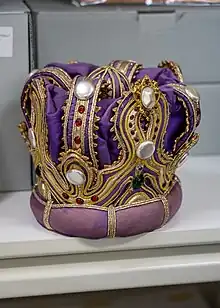
Kings of Moomba were named beginning in 1967. The role was awarded to male celebrities. It too was abolished following the 1987 festival as the gender-neutral monarch was introduced.[18][19]
Occasionally, a "court jester" was also named to accompany the king.
| Court jester |
Moomba Monarchs (1988–1998, 2010–present)
_Melbourne_(13054867724).jpg.webp)
In 1988, a gender-neutral Moomba Monarch position was established. Winners are typically celebrities and may be any gender. The first was television presenter Jo Pearson. In 1999 the tradition ended when clowns Zig and Zag were appointed. After it was revealed that, years before, Zig (Jack Perry) had pleaded guilty to child molestation, they were dethroned. In 2010 the tradition was restored, with Molly Meldrum and Kate Ceberano being named King and Queen of Moomba.[22]
On some occasions, non-celebrities have been named for various reasons.
| Non-celebrity |
| Year | Monarch/s | Nationality | Notability |
|---|---|---|---|
| 1988 | Jo Pearson | Television presenter | |
| 1989 | Con "the Fruiterer" Dikaletis | Character portrayed by Australian actor Mark Mitchell | |
| 1990 | David Hanison | Taxi driver | |
| 1991 | Tony Shaw | Australian rules footballer | |
| 1992 | Don Dunstan | Politician | |
| 1993 | Oarsome Foursome | Australian representative men's rowing coxless four crew, consisting of Andrew Cooper, Nick Green, Mike McKay and James Tomkins | |
| 1994 | Andrew Gaze | Basketballer | |
| 1995 | Cathy Freeman | Sprinter | |
| 1996 | Marina Prior | Singer and actor | |
| 1997 | Lano and Woodley | Comedy duo, consisting of Colin Lane ("Lano") and Frank Woodley | |
| 1998 | Denise Drysdale | Entertainer | |
| 1999–2009 | No Monarch[lower-alpha 1] | ||
| 2010 | Kate Ceberano | Singer | |
| Molly Meldrum | Music industry figure | ||
| 2011 | Mick Malthouse | Australian rules football coach | |
| Ruby Rose | Model and television presenter | ||
| 2012 | Natalie Bassingthwaighte | Entertainer | |
| Harry Kewell | Soccer player | ||
| 2013[lower-alpha 2] | Stephanie Carr | Department of Sustainability and Environment community engagement facilitator | |
| Karla Challis | Victoria Police family violence advisor | ||
| Alan Eade | Ambulance Victoria paramedic and St John Ambulance Australia chief commissioner | ||
| Sandy Faoro | Victoria State Emergency Service unit controller | ||
| April Himmelreich | Country Fire Authority volunteer firefighter | ||
| Scott McGraw | Metropolitan Fire Brigade firefighter | ||
| Brendan Nottle | Salvation Army commanding officer | ||
| 2014 | Lucy Durack | Actor | |
| Bert Newton | Entertainer | ||
| 2015 | Pallavi Sharda | Actor | |
| Shane Warne | Cricketer | ||
| 2016 | Michelle Payne | Jockey | |
| Stevie Payne | Michelle Payne's brother and strapper | ||
| 2017 | Guy Grossi | Chef | |
| Karen Martini | Chef | ||
| 2018 | Jimmy Giggle | Children's entertainer | |
| Chrissie Swan | Television personality | ||
| 2019 | Jane Bunn | Meteorologist and weather presenter | |
| Archie Thompson | Soccer player | ||
| 2020 | Nazeem Hussain | Comedian | |
| Julia Morris | Entertainer | ||
| 2021[lower-alpha 3] | Kirsty Buising | Infectious diseases physician | |
| Pravini Fernando | Cleaner | ||
| Drew Law | Supermarket worker | ||
| 2022 | Fifi Box | Radio presenter | |
| Peter Hitchener | Television presenter | ||
| 2023 | Rhonda Burchmore | Entertainer | |
| Rob Mills | Entertainer | ||
- ↑ Australian clowns Zig and Zag (portrayed by Jack Perry and Doug McKenzie respectively) had been announced as the 1999 Monarchs but not yet crowned when it became publicly known that Perry had sexually assaulted his granddaughter. As a result, the pair were not crowned. There was no replacement Monarch that year, and the concept as a whole was rested until 2010.
- ↑ In 2013, eight community and emergency services organisations (Ambulance Victoria, the Country Fire Authority, the Department of Sustainability and Environment, the Metropolitan Fire Brigade, The Salvation Army, St John Ambulance Australia, Victoria Police and Victoria State Emergency Service) were honoured by the monarchy. These were represented by seven monarchs (one of the monarchs represented both ambulance organisations).[23][24][25]
- ↑ In 2021, three workers in roles particularly affected by the COVID-19 pandemic were selected as monarchs.[26]
Queens of the Pacific (1967–1977)
The Queen of the Pacific was a title contested by representatives from various countries and administrations from the Pacific and South-East Asian regions. It was decided by a beauty contest.[27] The title was awarded from 1967 to 1977.
| Year | Monarch | Representing | Notes |
|---|---|---|---|
| 1967 | Betty Lim Saw Yim | ||
| 1968 | Baby Santiago | ||
| 1969 | Hiroko Suzuki | ||
| 1970 | Deirdre Bruton | ||
| 1971 | Nelia Sancho | ||
| 1972 | Abigail Banglos | ||
| 1973 | Irene Rebecca Soetanto | Runner Up of Ratu Indonesia (Queen of Indonesia) 1973 | |
| 1974 | Doris Dodge | ||
| 1975 | Fransisca Warastoeti | Winner of Puteri Indonesia (Miss Indonesia) 1975 | |
| 1976 | Suzie Cross | ||
| 1977 | Lei Maa |
Young Ambassadors (2003–200?)
The title of "Young Ambassador" was awarded during part of the period during which no monarchs were named (1999 to 2009). It was first awarded in 2003.[19][28]
| Year | Ambassador | Notability |
|---|---|---|
| 2003 | Carrie Stoney | Ultramarathoner supporting Beyond Blue (mental health) |
| 2004 | Sam Quinn | Australian Deaflympian basketballer |
| 2005 | Alan Wu | Youth advocate |
| 2006 | Natalie Bassingthwaighte | Entertainer |
| 2007 | Trisha Broadbridge | Boxing Day tsunami survivor and youth leader |
From approximately 1981 to 1988 there were also instances where Moomba included a Prince and Princess of Moomba designation consisting of two children chosen through a competition held by local radio station 3KZ.[29]
Fireworks
Fireworks are a big part of the Moomba festival and large displays occur on every night of the festival. The fireworks are above the Yarra river.
Carnival
A traditional carnival including a ferris wheel are held in the Alexandra Gardens along the river bank. In recent years, the carnival has extended to Birrarung Marr across the river. It is popular with children, and dagwood dogs and doughnut stands line the paths.
River activities
Moomba particularly celebrates the Yarra River, which has been much maligned during the history of the city until the last few decades.
Water skiing
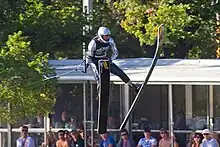
Water skiing in the Yarra was introduced to Moomba in 1959. The tournament has both Junior and Open divisions, with the finals crowning the Moomba Masters Champions on Moomba Monday.
River floats
The festival has featured Chinese dragon boats and the Moomba Showboat.
Birdman rally
Among the more popular events is the Birdman Rally, begun in 1976, which is traditionally held at the Swan Street Bridge over the Yarra River. However it has been held only intermittently during Moomba's history. It was stopped for a number of years due to high levels of E. coli contamination of the Yarra. Subsequent clean-ups reduced pollution to acceptable levels and 2004 saw its return. In 2005, the rally was held in the new inner city park, Birrarung Marr, close to its traditional location.[30][31]
Music and live bands
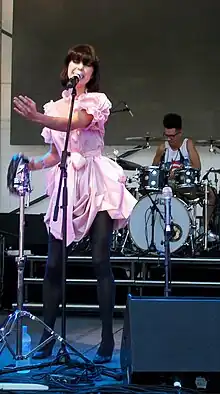
Moomba's performers have included international musical acts such as ABBA, Neil Diamond and AC/DC as well as a number of smaller local acts.
In 2012, performers included Tex Perkins and Daryl Braithwaite.
Citations
- ↑ Powley 2017.
- ↑ "'Moomba' gala next year". The Argus. 13 May 1954. Retrieved 16 October 2016.
- ↑ pg4. The Argus Wednesday 1 December 1954
- 1 2 Dubecki 2008.
- 1 2 Kelly 2011.
- ↑ Hercus 1969, p. 371.
- ↑ Moore 2001, p. 131.
- ↑ Blake 1981, p. 84.
- ↑ "It's a gay day today". The Argus. 12 March 1955. Retrieved 16 October 2016.
- ↑ "With the Churchmen: 'Moomba spirit leading us to decay". The Argus. 14 March 1955. Retrieved 16 October 2016.
- ↑ "Councillor defends Moomba". The Argus. 15 March 1955. Retrieved 16 October 2016.
- ↑ "Opening of the Herald Sun Art Show, East Melbourne Treasury Gardens, 1959". Victorian Places. Retrieved 28 October 2020.
- ↑ "The Herald Outdoor Art Show, Treasury Gardens, Melbourne". STATE LIBRARY VICTORIA. Retrieved 28 October 2020.
- ↑ Melbourne street brawl blamed on Apex gang after Moomba festival Sunday 13 March 2016. The Guardian Retrieved 18 May 2016
- ↑ "The Herald Outdoor Art Show, Treasury Gardens, Melbourne". State Library Victoria. Retrieved 28 October 2020.
- ↑ "Victoria records zero new local coronavirus cases, Moomba festival is called off". ABC News. Australian Broadcasting Corporation. 17 February 2021. Retrieved 20 February 2021.
Melbourne City Council says COVID-19 restrictions and the five-day lockdown mean it is not feasible to run Moomba.
- ↑ "Moomba 2.0 locked in for long weekend". www.melbourne.vic.gov.au (Press release). City of Melbourne. 19 February 2021. Retrieved 20 February 2021.
Moomba festival will proceed, with a revised program and format to ensure the event will delight Melbourne families and meet COVID-19 safety requirements.
- 1 2 Craig Bellamy, Gordon Chisholm, Hilary Eriksen (17 February 2006) Moomba: A festival for the people.: http://www.craigbellamy.net/images/moomba.pdf PDF pp 17-22
- 1 2 3 "Moomba Monarchs". Archived from the original on 14 July 2009. Retrieved 25 April 2012.
- ↑ "Beauty Queen Killed in Car Smash". The Sydney Morning Herald. 1 May 1966. Retrieved 12 July 2020.
- ↑ "Moomba king returns to throne". The Canberra Times. 8 March 1969. p. 3. Retrieved 21 August 2023 – via National Library of Australia.
- ↑ Barry, Evonne (16 February 2010). "Molly Meldrum and Kate Ceberano the new king and queen of Moomba". Herald Sun. Retrieved 12 July 2020.
- ↑ "Moomba 2013". Archived from the original on 21 February 2013. Retrieved 18 February 2013.
- ↑ Lee, Lionel (5 March 2013). "The 7 Kings and Queens of Moomba 2013". WeekendNotes. Retrieved 21 August 2023.
- ↑ "Moomba honours Victoria's unsung heroes". The Age. 18 February 2013. Retrieved 21 August 2023.
- ↑ Estcourt, David (1 March 2021). "'Everyday community heroes': Cleaner, supermarket worker and doctor honoured as 2021 Moomba monarchs". The Age. Retrieved 21 August 2023.
- ↑ "All quiet on Pacific front". The Canberra Times. 6 March 1968. p. 19. Retrieved 21 August 2023 – via National Library of Australia.
- ↑ Mary Bolling & Matthew Schulz, (12 March 2007) Moomba thrills young and old: http://www.news.com.au/story/0,23599,21366832-421,00.html article from Herald Sun
- ↑ Walker, R. R (1984). Dial 1179: The 3KZ Story. Curry O'Neil. p. 197. ISBN 9780855505967. OCLC 12663214.
- ↑ "Moomba Birdman Rally 2020". www.onlymelbourne.com.au. Retrieved 9 May 2019.
- ↑ "Is it safe to swim in the Yarra River?". ABC News. 25 May 2018. Retrieved 9 May 2019.
References
- Blake, Barry J. (1981). Australian Aboriginal Languages. Sydney: Angus & Robertson. ISBN 0-207-14044-8.
- Dubecki, Larissa (8 March 2008). "Let's have fun, said some, and name a festival 'Up Your Bum'". The Age.
- Kelly, Piers (14 March 2011). "Does 'Moomba' really mean 'up your bum'?". Crikey.
- Moore, Bruce (2001). "Australian English and Indigenous Voices". In Blair, David; Collins, Peter (eds.). English in Australia. John Benjamins Publishing. pp. 133–150. ISBN 978-9-027-29799-0.
- Hercus, Luise A. (1969). The Languages of Victoria: A Late Survey, Issue 6, Part 2. Australian Institute of Aboriginal Studies.
- Powley, Kathryn (10 March 2017). "Moomba 2017 guide: Melbourne's 'free community festival' has arrived". Herald Sun.
Other reading
Eckersley, M. 2012. 'Australian Indigenous Drama'. Tasman Press. Altona.